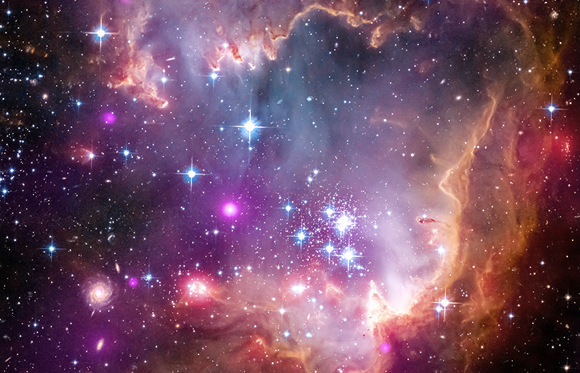
Our galaxy, the Milky Way, is more than just a giant barred spiral containing hundreds of billions of stars. It's also the centre of a colossal empire and rules over about 20 smaller galaxies that orbit around it, similar to the way our Moon orbits the Earth. The shining stars and glowing arcs of gas in this picture reside in one of these subjects: a dwarf galaxy called the Small Magellanic Cloud.
If you live in the Southern Hemisphere or near the equator, you may have noticed two bright but blurry clouds in the dark night sky. The smaller of these clouds is the Small Magellanic Cloud, one of the Milky Way's so-called 'satellite galaxies'. It is a dwarf galaxy, meaning that it contains far fewer stars than galaxies similar to our own. While the Milky Way is made up of about 300 billion stars, the Small Magellanic Cloud has just a couple of billion.
On a cosmic scale, this galaxy is extremely close by. Moving at the fastest speed known in the Universe (the speed of light), it would take less than 200 thousand years to travel there from Earth. This may not seem very close, but the galaxy we talked about in last week's Space Scoop is 47 million years away if you're moving at the same speed!
Being so close to us, the Small Magellanic Cloud offers astronomers an opportunity to study phenomena that are difficult to examine in more distant galaxies. This picture shows an area of the galaxy called the 'Wing'. It contains three star clusters that astronomers have been studying recently to find out how young stars are born.
Cool fact: The Small Magellanic Cloud began its career as a barred spiral galaxy, similar to the Milky Way. Over time, the gravity from nearby galaxies has pulled it into the irregular, chaotic form we see today.
Watch the video podcast
Do you want to learn more about this topic?
Visit the Chandra field guide or send us your questions in an email: cxcpub@cfa.harvard.edu
In cooperation with Space Scoop: Bringing news from across the Universe to children all around the world. Universe Awareness and the Chandra X-ray Observatory
| Children & Online Privacy |



